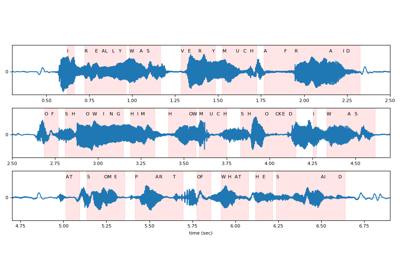CTCDecoder¶
- class torchaudio.models.decoder.CTCDecoder[source]¶
來自 Flashlight 的 CTC beam search 解碼器 [Kahn 等, 2022]。
注意
要構建解碼器,請使用工廠函式
ctc_decoder()。- 使用
CTCDecoder的教程
- 使用
方法¶
__call__¶
- CTCDecoder.__call__(emissions: FloatTensor, lengths: Optional[Tensor] = None) List[List[CTCHypothesis]][source]¶
執行批次離線解碼。
注意
此方法一次性執行離線解碼。要執行增量解碼,請參考
decode_step()。- 引數:
emissions (torch.FloatTensor) – 形狀為 (batch, frame, num_tokens) 的 CPU 張量,儲存標籤機率分佈序列;聲學模型的輸出。
lengths (Tensor 或 None, 可選) – 形狀為 (batch, ) 的 CPU 張量,儲存每個批次中輸出張量在時間軸上的有效長度。
- 返回:
批次中每個音訊序列的排序後的最佳假設列表。
- 返回型別:
List[List[CTCHypothesis]]
decode_begin¶
- CTCDecoder.decode_begin()[source]¶
初始化解碼器的內部狀態。
用法請參考
decode_step()。注意
此方法僅在執行線上解碼時需要。使用
__call__()執行批次解碼時無需此方法。
decode_end¶
- CTCDecoder.decode_end()[source]¶
終結解碼器的內部狀態。
用法請參考
decode_step()。注意
此方法僅在執行線上解碼時需要。使用
__call__()執行批次解碼時無需此方法。
decode_step¶
- CTCDecoder.decode_step(emissions: FloatTensor)[source]¶
在當前內部狀態的基礎上執行增量解碼。
注意
此方法僅在執行線上解碼時需要。使用
__call__()執行批次解碼時無需此方法。- 引數:
emissions (torch.FloatTensor) – 形狀為 (frame, num_tokens) 的 CPU 張量,儲存標籤機率分佈序列;聲學模型的輸出。
示例
>>> decoder = torchaudio.models.decoder.ctc_decoder(...) >>> decoder.decode_begin() >>> decoder.decode_step(emission1) >>> decoder.decode_step(emission2) >>> decoder.decode_end() >>> result = decoder.get_final_hypothesis()
get_final_hypothesis¶
- CTCDecoder.get_final_hypothesis() List[CTCHypothesis][source]¶
獲取最終假設
- 返回:
排序後的最佳假設列表。
- 返回型別:
List[CTCHypothesis]
注意
此方法僅在執行線上解碼時需要。使用
__call__()執行批次解碼時無需此方法。
idxs_to_tokens¶
支援結構¶
CTCHypothesis¶
- class torchaudio.models.decoder.CTCHypothesis(tokens: torch.LongTensor, words: List[str], score: float, timesteps: torch.IntTensor)[source]¶
表示由 CTC beam search 解碼器
CTCDecoder生成的假設。- 使用
CTCHypothesis的教程
- tokens: LongTensor¶
預測的 token ID 序列。形狀為 (L, ),其中 L 是輸出序列的長度
- words: List[str]¶
預測的單詞列表。
注意
此屬性僅在為解碼器提供了詞典時適用。如果在沒有詞典的情況下進行解碼,此屬性將為空。請參考
tokens和idxs_to_tokens()。
- timesteps: IntTensor¶
與 token 對應的時間步。形狀為 (L, ),其中 L 是輸出序列的長度
- 使用
CTCDecoderLM¶
- class torchaudio.models.decoder.CTCDecoderLM[source]¶
用於建立自定義語言模型以與解碼器一起使用的語言模型基類。
- 使用
CTCDecoderLM的教程
- abstract start(start_with_nothing: bool) CTCDecoderLMState[source]¶
初始化或重置語言模型。
- 引數:
start_with_nothing (bool) – 是否以 sil token 開始句子。
- 返回:
起始狀態
- 返回型別:
- abstract score(state: CTCDecoderLMState, usr_token_idx: int) Tuple[CTCDecoderLMState, float][source]¶
根據當前 LM 狀態和新單詞評估語言模型。
- 引數:
state (CTCDecoderLMState) – 當前 LM 狀態
usr_token_idx (int) – 單詞的索引
- 返回:
- (CTCDecoderLMState, float)
- CTCDecoderLMState
新的 LM 狀態
- float
得分
- abstract finish(state: CTCDecoderLMState) Tuple[CTCDecoderLMState, float][source]¶
根據當前 LM 狀態評估語言模型的結束。
- 引數:
state (CTCDecoderLMState) – 當前 LM 狀態
- 返回:
- (CTCDecoderLMState, float)
- CTCDecoderLMState
新的 LM 狀態
- float
得分
- 使用
CTCDecoderLMState¶
- class torchaudio.models.decoder.CTCDecoderLMState[source]¶
語言模型狀態。
- 使用
CTCDecoderLMState的教程
- property children: Dict[int, CTCDecoderLMState]¶
索引到 LM 狀態的對映
- child(usr_index: int) CTCDecoderLMState[source]¶
返回與 usr_index 對應的子狀態,如果未找到輸入索引,則建立並返回一個新狀態。
- 引數:
usr_index (int) – 與子狀態對應的索引
- 返回:
與 usr_index 對應的子狀態
- 返回型別:
- compare(state: CTCDecoderLMState) CTCDecoderLMState[source]¶
比較兩個語言模型狀態。
- 引數:
state (CTCDecoderLMState) – 用於比較的 LM 狀態
- 返回:
如果狀態相同返回 0,如果 self 小於 state 返回 -1,如果 self 大於 state 返回 +1。
- 返回型別:
- 使用

